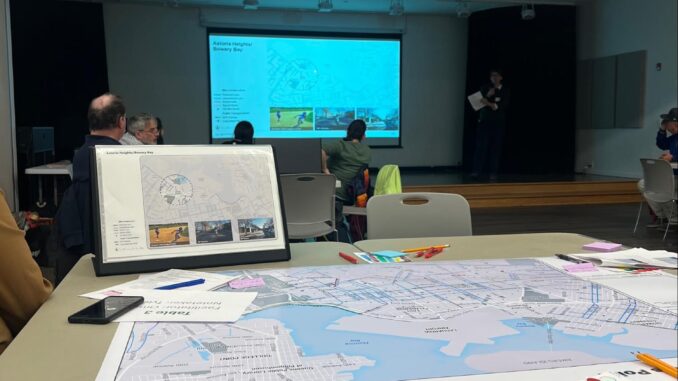
By Angelina Banek
Greenways are public car-free public roadways that provide a safe way for people to walk and bike without competing with car traffic. In Queens, the New York City Department of Transportation is working with the community to connect shorter greenway routes to create an 18-mile route along the Northern Queens Waterfront.
On Wednesday night DOT hosted a community workshop about expanding the Queens Waterfront Greenway by connecting Gantry State Plaza and Fort Totten Park with bike paths and walkways. This is one of six greenways being developed across New York City.
At Glow Cultural Center in Flushing, the room was full of motivated and engaged DOT employees and community members gathered around six tables. DOT staff set up two white boards with questions for people to answer, and asked participants to leave their replies on post-it notes. The first question was, “what would you like to get out of the greenway?” One post-it response read “waterfront,” another said “safe and convenient bike route from Forest Hills.”
During the workshop, Mya Dutta, a planner with NYC Parks, described how the plan links local public parks like Flushing Meadows Corona Park with other parks, including Astoria and Gantry.
“As you know, there are lots of beautiful parks in this area, and we think this is a great opportunity to work together to find some great connections to and through the parks around us,” she said.
Data from The New York City Parks Department Vital Parks Explorer shows that those living near the greenway are currently underserved. According to the program, only 5% of residents in the area of Queens Community Board 3 live within a 10-minute walk of a waterfront, compared with a citywide average of 30%. Theoretically, the construction of this greenway would improve access to these spaces within this district.
Notably, this greenway would also pass near Laguardia Airport. According to the Port Authority 2023 Air Traffic Report, approximately 40,500 people are employed at the airport. During the workshop, DOT expressed interest in providing a safe way for these employees to commute to work by bike.
The project is being funded by a 7.24 million dollar federal RAISE grant Mayor Adams received in 2022 for the purpose of expanding greenways throughout the city. RAISE stands for Rebuilding American Infrastructure with Sustainability and Equity.
Jason Banrey, the Queens Deputy Borough Commissioner at DOT, encouraged community members to share information about any issues they’ve had while using their bikes on roads in Queens.
“Even though this is part of a planning process, myself and the Queens Borough Commissioner team, we have planners that work day to day operations. So, share anything that we can pull from this information and do things now,” he told community members.
According to Banrey, this greenway project will be completed within two years. This is a joint project between NYC Parks, the Department of Economic Development, and DOT.
The main points of discussion were the current condition of bike routes throughout Queens, the plan to build a safer route between Bowery Bay and Willets Point, and what exactly a greenway is.
“We do think of greenways as primarily a continuous transportation corridor, that continuous piece is very important,” said Emma Maniere, a project manager for the DOT bikes team.
A popular Queens greenway is the path along the East River in Astoria Park. Maniere described this as an example of the ideal greenway project.
“That’s kind of the gold standard we’re shooting for,” she said. “It’s continuous, so the ride is more or less seamless and uninterrupted by traffic.”
New York League of Conservation Voters, NYC Greenways Coalition, and Transportation Alternatives are just a few of the many organizations that campaigned and advocated for the construction of this greenway path. Alexa Sledge, Director of Communications at Transportation Alternatives, expressed excitement for the plan.
“We’re huge supporters of the greenway and will continue to be, but obviously just one greenway, or even greenways across the five boroughs isn’t enough,” she said. “We also need an entire network of protected bike lanes so people can get where they need to go. The greenway is awesome if you’re starting at a greenway and ending at a greenway, but you need a bike safe lane no matter where you’re going.”
Data from the DOT revealed 30 people died on bikes last year. According to a Transportation Alternatives press release, 2023 was the deadliest year for cyclists since 1999.
“We see time and time again that one of the main reasons people don’t bike is they don’t think it’s safe and that’s especially true for women, so having more and safer places to bike is just absolutely critical,” Sledge said.
There are a number of ways New Yorkers can make their voices heard when it comes to essential transportation needs. Sledge mentioned Transportation Alternative’s activist committees and other activist groups like Rider’s Alliance. She also suggested ways people can start thinking differently about transit activism, such as speaking with neighbors and working with others to start new initiatives.
“There’s tons of people out there who have really similar goals and are happy to work with you, and align with you, and push forward on these advancements,” she said.
The workshop was part of a series of public community discussions about the Queens Waterfront Greenway. On Oct. 29th, 2024 the last workshop will be held on Zoom and will discuss all sections of the 16 mile plan to close gaps and improve conditions along the waterfront.
